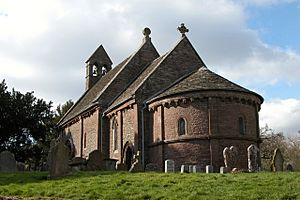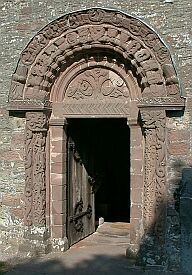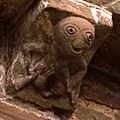Church of St Mary and St David, Kilpeck facts for kids
Quick facts for kids Church of St Mary and St David, Kilpeck |
|
|---|---|

Kilpeck Church
|
|
| Lua error in Module:Location_map at line 420: attempt to index field 'wikibase' (a nil value). | |
| Location | Kilpeck, Herefordshire |
| Country | England (previously Wales) |
| Denomination | Church of England |
| History | |
| Dedication | St Mary St David |
| Architecture | |
| Years built | c. 1140 |
| Administration | |
| Parish | Parish of Kilpeck |
| Diocese | Hereford |
| Province | Canterbury |
The Church of St Mary and St David is a special Church of England parish church located in Kilpeck, Herefordshire, England. It's about 5 miles from the border with Monmouthshire, Wales. Experts like Pevsner call Kilpeck "one of the most perfect Norman churches in England." It's famous for its amazing stone carvings and is a Grade I listed building, which means it's a very important historic site.
Contents
History of Kilpeck Church
The church was built around the year 1140. It was likely finished before 1143, when it was given to the Abbey of Gloucester. It might have replaced an older Saxon church that stood on the same spot. The oval shape of the churchyard suggests it could be even older, possibly from Celtic times.
Early Beginnings and Dedication
In the 6th and 7th centuries, the Kilpeck area was part of an old British kingdom called Ergyng. This kingdom kept Christian traditions from the late Roman period. The church was first dedicated to Saint David, who was probably a local Celtic holy person. Later, it also became dedicated to Mary. This happened after a chapel at Kilpeck Castle fell apart.
Why the Church Was Preserved
The church's design, with a nave (main part), chancel (area around the altar), and a round apse (curved end), was typical for the Norman period. At the time it was built, the area around Kilpeck was important and wealthy. However, after the 14th century, the area became less prosperous. This decline might have helped keep the church's unique features safe. Many churches elsewhere had their old parts removed. It's also a mystery why Puritans didn't damage the carvings in the 17th century.
Restoration Work
The church has been carefully repaired several times. Major repairs happened in 1864, 1898, and 1962. These efforts helped protect and maintain its special features. The Victorian-era repairs were done very well, keeping the church's original style.
Architecture and Amazing Carvings
The church is made of local red sandstone. Its carvings are truly special because there are so many of them, and they are still in great condition. You can see them especially around the south door, the west window, and along a line of corbels (stone supports) that go all around the outside of the church. All these carvings are original and are still in their first places.
The Herefordshire School of Masons
These carvings were likely made by a group of stonemasons known as the Herefordshire School. They were probably local artists. However, they might have learned from master masons brought from France. These French masons were hired by Oliver de Merlimond, who worked for Hugh Mortimer, a powerful lord. Hugh Mortimer went on a pilgrimage to Spain. When he returned, he built a church with similar carvings at Shobdon. Hugh de Kilpeck, a relative of Mortimer, hired the same builders for Kilpeck. Their work can also be seen at Leominster and Rowlestone.
The South Door Carvings
The south door has double columns. The outer columns show carvings of snakes, with their heads swallowing their tails. The meaning of these carvings isn't fully clear. They might represent new beginnings, like a snake shedding its skin. The inner right column has birds among plants. At the top of the right columns, there's a "Green Man" carving. The inner left column shows two warriors wearing loose trousers, which is unusual.
Above the doorway, the outer parts of the arch show creatures like a manticore and a basilisk. There are also other mythical and real birds and animals. The semicircular space above the door, called a tympanum, shows a tree of life.
-
An angel appears in the centre of the arch above the south door.
For many years, a wooden porch covered the south door. This porch was removed in 1868 so visitors could see the carvings as they were meant to be seen. Even though the doorway is now open to the weather, the sandstone is very strong. Its condition is checked carefully. In 1968, a thin strip of lead was added above the arch. This helps protect the carvings from water running down the wall.
Corbels and Other Figures
There are 85 corbels still remaining on the church. These are stone supports under the roof. Their meanings are often a mystery. Some might be from a bestiary (a book about animals). One of the most famous corbels is a unique figure.
Two "green men" carvings appear as decorative tops on the columns of the west window. In the middle of the stone supports below the window, and at each corner of the nave's west wall, are large dragon heads sticking out. They have coiled tongues. Each of the three dragon mouths is open differently, almost like a moving picture.
Inside the Church
Inside the church, the arch leading to the chancel is also richly carved. While not as grand as the south doorway, its figures are very detailed. The center stone of the apse (the curved end) shows four lion heads. There's also a large baptismal font made of polished stone. A unique holy water stoup (a basin for holy water) is shaped like a body. It was brought from a chapel near Wormbridge. There's also a rare Romanesque font-stopper.
A simple belfry (bell tower) now stands on the roof. Even though it looks like the rest of the church, it was added in the 1800s. The church has been well-preserved through careful restoration and necessary updates.
Churchyard
The churchyard is the area around the church. It contains the war grave of an officer from World War II. This officer was part of the King's Shropshire Light Infantry.
Kilpeck Church in Literature
The church has inspired writers. A short story by British author B. S. Johnson is set at the church.
Jeff Nuttall, a writer, studied the church in 1954. He wrote that the church was not just a building. It was "a work of art, the timeless expression of a vision."
A poem by Gillian Clarke was also inspired by the carvings at Kilpeck.
Images for kids










